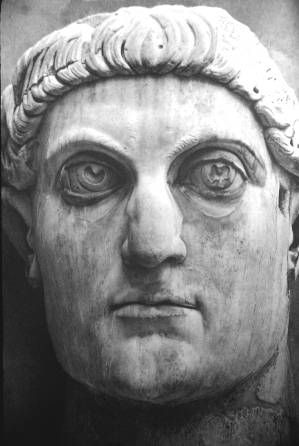
Background
Constanine was the son of Constantius. Constantius had a position of authority under Maximian before succeeding him as Augustus in 305.
Constantius died a year after assuming power, in 306, which sparked conflict over who would succeed him.
Constantine had the support of his father's army but handed it over to Severus, who was under his father during his reign.
Maximian's son, Maxentius challenged opposed Constantine by declaring himself emperor and defeating the army under Severus' control in 306 and 307.
In 311 Maxentius declared war on Constantine, trying to defeat him for good and claim power over Rome.
In the spring of 312 Constantine led his forces toward Rome to combat Maxentius, seeking to claim power over Rome. He arrived in Rome in October.
Constantine's Vision
According to tradition, on the day before the two armies were about to meet for battle on October 27, Constantine saw a vision.
Constantine's vision instructed him to fight in the name of Christ, with his soldiers' sheilds bearing the sign of Christ. The symbol was either a cross or a laberum, an intersection of the chi (X) and rho (P), the letters of Christ.

Christian author Lactantius, writing several years after the battle, described, “Constantine was directed in a dream to cause the heavenly sign to be delineated on the shields of his soldiers, and so to proceed to battle. He did as he had been commanded, and he marked on their shields the letter Χ, with a perpendicular line drawn through it and turned round thus at the top, being the cipher of Christ. Having this sign (ΧР), his troops stood to arms.”
The author Eusebius, a Constantine apologist, also described the event in “Life of Constantine,” which he wrote after Constantine’s death in 337. According to Eusebius, Constantine saw a vision of a cross rather than the letters of Christ.
“He saw with his own eyes the trophy of a cross of light in the heavens, above the sun, and bearing the inscription, CONQUER BY THIS. At this sight he himself was struck with amazement, and his whole army also, which followed him on this expedition, and witnessed the miracle,” wrote Eusebius.
The following day, Constantine’s outnumbered forces defeated Maxentius’ forces, which tried to retreat over the Tiber River on a pontoon bridge. In the chaos of the retreat, the bridge collapsed, leaving only the too-narrow Milvian Bridge as a route to escape. Maxentius and many of his men would drown or be trampled to death in the escape. Constantine rode into Rome with the head of Maxentius.
“There, at around the age of twenty-four, Constantine was hailed as emperor, of the western half of the empire,” writes historian Frank E. Smitha. “He was hailed as a man of boldness and a man favored and guided by the gods.”
Constantine Legalizes Christianity
Christians in the Roman Empire had been persecuted by several Roman emperors in the first, second and third centuries, dating back to Nero in 64 A.D. In the early fourth century, Diocletian and Galerius made Christianity illegal, and called for the burning of churches and torture of Christians who refused to recant.
Constantine’s rise to power marks a turning point in the history of Christianity. “Constantine can rightfully claim the title of Great, for he turned the history of the world into a new course and made Christianity, which until then had suffered bloody persecution, the religion of the State,” writes the Catholic Encyclopedia.
Constantine did not immediately make a full conversion to Christianity, however. He retained many of his pagan beliefs and customs.
He converted on his deathbed.
He ordered the toleration of Christians in the Edict of Milan of 313.
He also granted powers and funding to Christian bishops, allowing them to build churches, restore pilgrimage sites, and spread a unified belief structure.
Council of Nicea
In 325, Constantine hosted the Council of Nicea, the first ever Ecumenical council, to settle a dispute primarily between Alexander and Arius over whether Jesus was as divine as God. Constantine oversaw a compromise, called the Nicene Creed, that said Jesus was of the same substance as God.
“The emperor then exiled Arius, an act that, while manifesting a solidarity of church and state, underscored the importance of secular patronage in ecclesiastical affairs,” according to Encyclopedia Britannica.
Spread of Christianity in Roman Empire
Christianity spread slowly over the next two centuries.
Only one emperor, Julian in the 360's, tried to oppress it.
By the end of the fourth century Christianity was the dominant religion in the Roman Empire.
Source of Information:
http://www.findingdulcinea.com/news/on-this-day/Oct/Constantine-Has-Christian-Vision-Before-Battle.html




Another aspect of the development of the Nicene Creed was specifically to weed out the Gnostic Christians who believed that all humanity is equal to God because we all hold the divine spark in our soul.
ReplyDeleteThe Gnostics believed that the soul was wholly unaffected by actions of the flesh, which removed the Church's power to control followers through the fear of committing sin. Finally, the Gnostic Christians found the idea of a physical resurrection of the dead wholly repulsive. Therefore, with the creation of this Creed, the Gnostic could not repeat it in good faith as part of the worship service without seeing themselves as hypocrites. Interestingly, the Gnostic Christians primarily were of the higher classes, more formally educated and well placed merchants.
As the church grew and gained political power they harassed and killed the Gnostic Christians just as they themselves had been tortured and killed in the previous centuries; their actions a far cry from the alleged teachings of their founder.